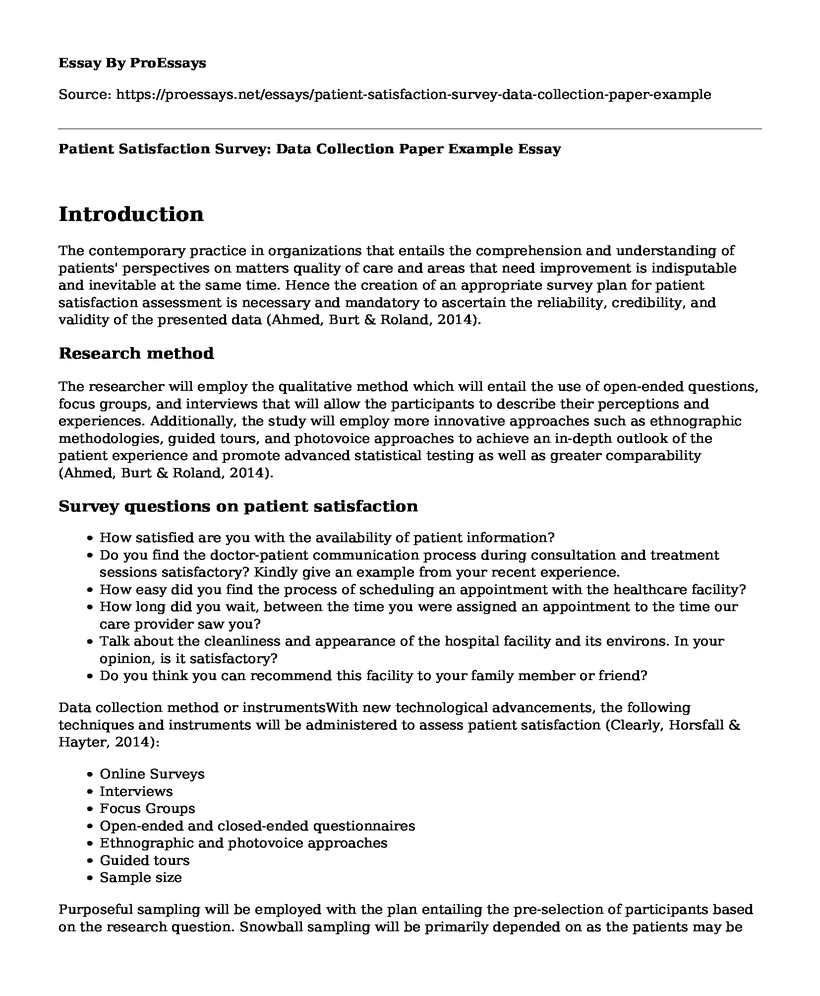Introduction
The contemporary practice in organizations that entails the comprehension and understanding of patients' perspectives on matters quality of care and areas that need improvement is indisputable and inevitable at the same time. Hence the creation of an appropriate survey plan for patient satisfaction assessment is necessary and mandatory to ascertain the reliability, credibility, and validity of the presented data (Ahmed, Burt & Roland, 2014).
Research method
The researcher will employ the qualitative method which will entail the use of open-ended questions, focus groups, and interviews that will allow the participants to describe their perceptions and experiences. Additionally, the study will employ more innovative approaches such as ethnographic methodologies, guided tours, and photovoice approaches to achieve an in-depth outlook of the patient experience and promote advanced statistical testing as well as greater comparability (Ahmed, Burt & Roland, 2014).
Survey questions on patient satisfaction
- How satisfied are you with the availability of patient information?
- Do you find the doctor-patient communication process during consultation and treatment sessions satisfactory? Kindly give an example from your recent experience.
- How easy did you find the process of scheduling an appointment with the healthcare facility?
- How long did you wait, between the time you were assigned an appointment to the time our care provider saw you?
- Talk about the cleanliness and appearance of the hospital facility and its environs. In your opinion, is it satisfactory?
- Do you think you can recommend this facility to your family member or friend?
Data collection method or instrumentsWith new technological advancements, the following techniques and instruments will be administered to assess patient satisfaction (Clearly, Horsfall & Hayter, 2014):
- Online Surveys
- Interviews
- Focus Groups
- Open-ended and closed-ended questionnaires
- Ethnographic and photovoice approaches
- Guided tours
- Sample size
Purposeful sampling will be employed with the plan entailing the pre-selection of participants based on the research question. Snowball sampling will be primarily depended on as the patients may be best placed to know friends and relatives who might have received treatment in the hospital and might be willing to participate in the study. The selection of the sample will be representative of the population in adherence to high standards of carrying out survey methodology, where the acceptable healthcare monitoring routine requires a 30-40% response rate (Palinkas et al., 2015). The sample population will include a subset of individuals comprising of past and current patients within the last five years. The participants will be given an opportunity to engage in the study voluntarily.
Rationale for choices
The collection of data pertaining to patient experience is initial in helping care providers to comprehend the opportunities and challenges in the improvement of the quality of healthcare. The methods were chosen because of the reasonable costs associated with their routine data collection and analysis (Brown, 2016). The rationale behind selecting qualitative methodologies is because the method offers a researcher the opportunity to understand patient experiences in depth. Through traditional methods such as focus groups, interviews and modern, innovative approaches such as ethnographic and photovoice methods, the study may better understand the perspectives of patients while engaging the care providers in improving the health of patients and quality of care as they move beyond the limitations that structured questions present (Palinkas et al., 2015)
Reliability and validity
To ascertain content-related validity and reliability, the researcher will consider the consistency of the responses across the patients, time and all care items per scale, in a bid to achieve the acceptable reliability (>0.8). Moreover, the researcher settled on the tools and methods outlined herein to help distinguish random variation of responses by reason of chance from substantial differences amongst providers. The sample selection plan eliminates cases of low reliability and response rates (Fawcett & Garit, 2009).
References
Ahmed, F., Burt, J., & Roland, M. (2014). Measuring patient experience: concepts and methods. The Patient-Patient-Centered Outcomes Research, 7(3), 235-241.
Cleary, M., Horsfall, J., & Hayter, M. (2014). Data collection and sampling in qualitative research: does size matter?. Journal of advanced nursing, 70(3), 473-475.
Fawcett, J., & Garity, J. (2009). Evaluating research for evidence-based nursing. Philadelphia, PA: F.A. David Company.
Palinkas, L. A., Horwitz, S. M., Green, C. A., Wisdom, J. P., Duan, N., & Hoagwood, K. (2015). Purposeful sampling for qualitative data collection and analysis in mixed method implementation research. Administration and Policy in Mental Health and Mental Health Services Research, 42(5), 533-544.
Cite this page
Patient Satisfaction Survey: Data Collection Paper Example. (2022, Jun 27). Retrieved from https://proessays.net/essays/patient-satisfaction-survey-data-collection-paper-example
If you are the original author of this essay and no longer wish to have it published on the ProEssays website, please click below to request its removal:
- Community Settings for Family Health Nurses - Paper Example
- Financial Stress on Caregivers of Dementia Patients
- Essay on COVID-19: Recognizing a National Security Threat through Human Behavior
- Access to Water: Essential for Life & Public Health - Essay Sample
- Essay Example on Shift Changes: Impact on Nursing Teams & Patient Safety
- Achieving Brand Loyalty: A Continuous Challenge for Every Business - Essay Sample
- Free Essay Sample on Healthy Lifestyle Resources in NYC







